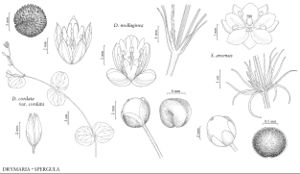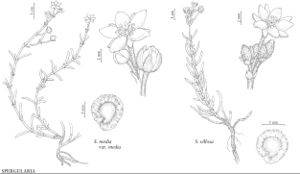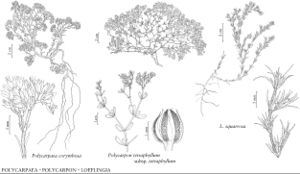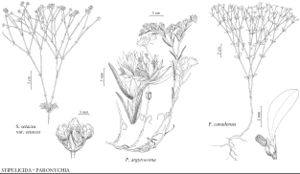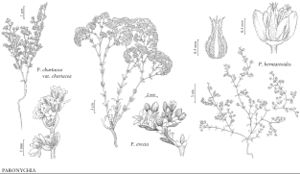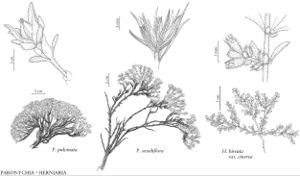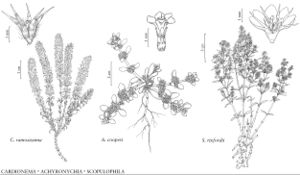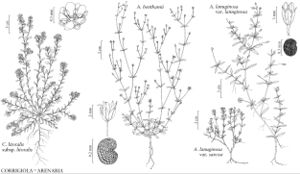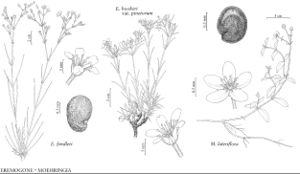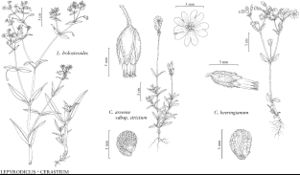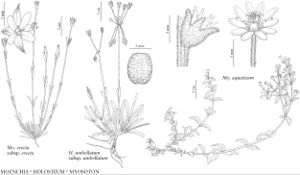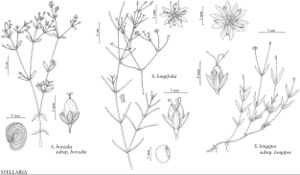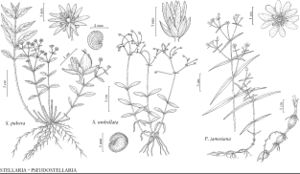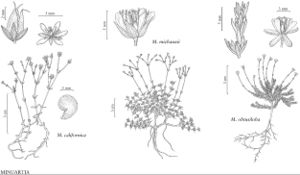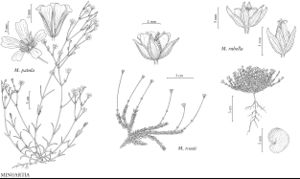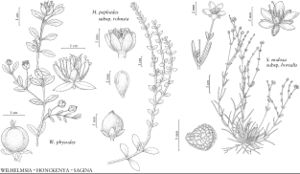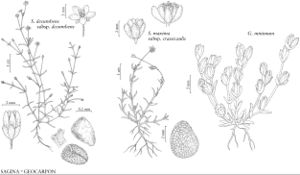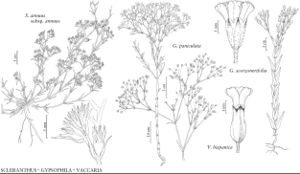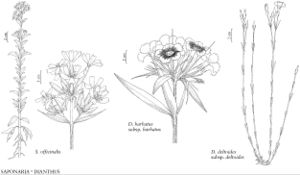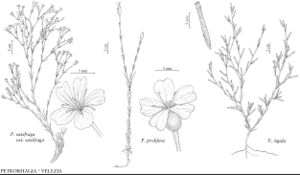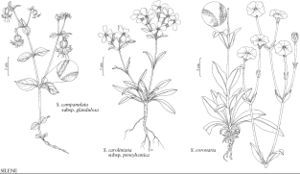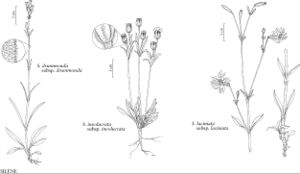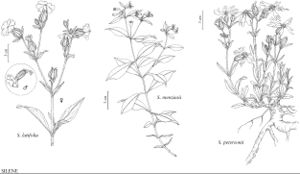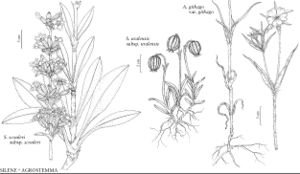Herbs [small trees, shrubs, or vines], winter-annual, annual, biennial, or perennial, glabrous or pubescence of simple hairs or stalked glands; taprooted and/or rhizomatous with fibrous-roots, sometimes from woody caudex, rhizomes rarely with tuberous thickenings. Stems erect to prostrate, often with swollen nodes, herbaceous. Leaves opposite, pseudoverticillate, whorled, or rarely alternate, distinct or connate proximally, simple; petiole often present; stipules present or absent; blade subulate to linear, spatulate to broadly ovate or suborbiculate, succulent or not, margins entire. Inflorescences terminal or axillary cymes, thyrses, or capitula, or flowers solitary; bracts usually paired, foliaceous or reduced, herbaceous to scarious, or absent; involucel bracteoles (epicalyces) immediately subtending calyx occasionally present. Pedicels present, or flowers sessile. Flowers bisexual or occasionally unisexual, radially symmetric; perianth and androecium hypogynous or perigynous; hypanthium, when present, urceolate, cup, disc, or dish-shaped, sometimes abruptly expanded distally; sepals persistent in fruit, (3-) 4-5, distinct or connate proximally into cup or tube, herbaceous or scarious, apex sometimes hooded or with apical or subapical spine; petals absent or (1-) 4-5, often fugacious in Polycarpon, distinct, often clawed, auricles present or absent, coronal appendages present or absent, blade apex entire, notched, or 2 (-4) -fid, sometimes dentate or laciniate; stamens 1-10, in 1 or 2 whorls, arising from base of ovary, nectariferous disc, or hypanthium rim, absent in pistillate flowers; staminodes usually absent, or 1-10 or 16-19; ovary 1, superior, 1-locular, rarely 2-locular proximally, or 3-5 locular, placentation free-central, basal, or axile in proximal half; ovules mostly campylotropous, bitegmic, crassinucellate; styles 1-5 (-6), distinct or connate proximally, absent in staminate flowers; stigmas 2-5 (-6), linear along adaxial surface of styles (or style-branches), subcapitate, or terminal, papillate or obscurely so, absent in staminate flowers. Fruits capsules, carpels opening into entire valves or valves split axially into teeth to divided to base, or a usually indehiscent utricle; carpophore sometimes present. Seeds 1-150 (-500+), often brown or black, sometimes white or yellowish to tan, reniform or triangular to globose and often laterally compressed, sometimes shield-shaped or oblong and dorsiventrally compressed, horizontal wing sometimes present, spongy appendage (strophiole) rarely present (Moehringia); embryo often peripheral, curved, surrounding the perisperm, rarely annular or central and straight; endosperm absent.
Distribution
Worldwide, especially north-temperate, montane and alpine, and Mediterranean areas
Discussion
Genera 83 or 89, species ca. 3000 (37 genera, 286 species in the flora).
In addition to the species treated here, Illecebrum verticillatum Linnaeus was collected in 1912 as a weed in a plant nursery in Reading, Massachusetts. This species of Europe and the Mediterranean region resembles species of Herniaria or Paronychia; it is distinguished by minute stipules and white, spongy, awned sepals.
Caryophyllaceae includes 54 locally endemic genera (many of them in the eastern Mediterranean region of Europe, Asia, and Africa), cultivated taxa (especially Dianthus, Gypsophila, and Silene), and weedy taxa (mostly from Eurasia). Of the 37 genera in the flora area, 15 are entirely non-native: Agrostemma, Corrigiola, Gypsophila, Holosteum, Lepyrodiclis, Moenchia, Myosoton, Petrorhagia, Polycarpaea, Polycarpon, Saponaria, Scleranthus, Spergula, Vaccaria, and Velezia.
Caryophyllaceae and Molluginaceae are exceptional in Caryophyllales in possessing anthocyanin pigments rather than betalains. Evidence from morphology (e.g., pollen type, sieve-tube plastids) and molecular studies confirms this alignment. S. R. Downie et al. (1997) studied the ORF2280 plastid gene and noted that Caryophyllaceae is monophyletic and a sister group to a clade containing Chenopodiaceae + Amaranthaceae.
The number of genera recognized within Caryophyllaceae depends on adoption of a broad (as here) or narrow (see B. Oxelman et al. 2000) circumscription of Silene, the largest genus in the family. The number of genera increases to over 120 if, as done by some Old World authors, segregates of Silene and other large genera (Arenaria, Gypsophila, Minuartia, Saponaria, and Stellaria) are recognized. Molecular evidence reinforces recognition of six monophyletic segregates from Silene in the broad sense and one from Arenaria (Eremogone); further studies may provide evidence that additional groups within the larger genera are monophyletic and deserve separate generic recognition.
Interpretation of appendages, sometimes petal-like, in some members of the Paronychioideae has been debated. Some workers (e.g., V. Bittrich 1993; A. Cronquist 1981) have considered them petals; we follow L. Petrusson and M. Thulin (1996) in considering these structures to be staminodes that replace the inner whorl of stamens. When present, these structures alternate with the fertile stamens and arise together from the same hypanthial rim.
Depending on the characters emphasized, the Caryophyllaceae can be divided into three, four, or five subfamilies; we accept four in this treatment. The “traditional” division recognizes three subfamilies: Paronychioideae (stipules present, sepals distinct; genera 1-13), Alsinoideae (stipules absent, sepals mostly distinct; genera 14-29), and Caryophylloideae (stipules absent, sepals connate proximally into a cup or tube; genera 30-37). We recognize also Polycarpoideae, moving to it the paronychioid species having capsules (genera 1-7), and retaining in Paronychioideae those species with utricles (genera 8-13). This alignment, suggested by M. G. Gilbert (1987), is also consistent with the concept that some authors (e.g., J. Hutchinson 1973) have followed in segregating Paronychioideae in the narrow sense as the Illecebraceae. A. Takhtajan (1997) segregated the Scleranthoideae (Pentastemonodiscus and Scleranthus) from the Alsinoideae on the basis of their having connate sepals and a utricle but lacking stipules. While not addressing Takhtajan's concept directly, R. D. Smissen et al. (2003) showed that molecular data favor continued placement of Scleranthus within the Alsinoideae. Results from molecular studies (M. Nepokroeff et al. 2002; Smissen et al. 2002) have suggested that the traditional morphological characters may not reflect the phylogeny within the family.
Selected References
Lower Taxa
Illustrations
Key
| 1 | Leaves with stipules present, stipules ovate to spatulate, triangular, or bristlelike, mostly scarious | > 2 |
| 1 | Leaves with stipules absent | > 15 |
| 2 | Fruits utricles (± modified in Achyronychia, Scopulophila); seed 1; petals absent; staminodes petaloid or scalelike; flowers perigynous; stamens arising from hypanthium rim [43b. subfam. Paronychioideae] | > 3 |
| 2 | Fruits capsules; seeds 3-150+; petals rarely absent or replaced by staminodes; flowers hypogynous (stamens arising from ovary base) or sometimes perigynous (stamens arising from rim of hypanthium or disc surrounding ovary base) [43 a. subfam. Polycarpoideae, in part] | > 8 |
| 3 | Leaves alternate or rarely subopposite; staminodes petaloid, ovate to oblong | Corrigiola |
| 3 | Leaves opposite (or occasionally distalmost alternate in Herniaria); staminodes not petaloid (narrowly lanceolate in Scopulophila), subulate to narrowly oblong | > 4 |
| 4 | Sepals broadly ovate to reniform, margins white, scarious, awns absent; staminodes 14-19 and filiform or 5 and petaloid, lanceolate | > 5 |
| 4 | Sepals lanceolate to oblong (if ovate or obovate, then margins scarious and awns present or margins herbaceous and awns absent), margins herbaceous or scarious; staminodes 4-5, filiform or subulate, or absent | > 6 |
| 5 | Plants annual, base ± glabrous; stems prostrate to ascending; staminodes 14-19, filiform; styles 2-branched | Achyronychia |
| 5 | Plants perennial, base densely woolly; stems ascending to erect; staminodes5, oblong, petaloid; styles 3-branched | Scopulophila |
| 6 | Stipules inconspicuous; sepals obtuse, awnless, margins green, herbaceous | Herniaria |
| 6 | Stipules often conspicuous; sepals hooded or awned, margins white, scarious | > 7 |
| 7 | Sepal awns very stout, spinose, 1.5-4 mm; flowers densely woolly | Cardionema |
| 7 | Sepals awnless or awns threadlike to somewhat stout, not especially spiny, 0.3-1.5(-2.1) mm; flowers not woolly, hairs ± straight or tips coiled | Paronychia |
| 8 | Basal leaf blades spatulate to obovate, stipules in tuft of 2-14+, filiform, scarious; cauline leaf blades subulate to triangular, scalelike, stipules forming incised or notched nodal fringe | Stipulicida |
| 8 | Basal leaves present or absent, if blade spatulate to ovate, then stipules 2 or 4 per node, not as a tuft; cauline leaf blades subulate to linear, lanceolate, ovate, or orbiculate, not scalelike, stipules bristlelike to triangular, not forming nodal fringe | > 9 |
| 9 | Styles 1, or (2-)3, connate proximally for 2 or more of length or rarely distinct | > 10 |
| 9 | Styles 3 or 5, occasionally 2, distinct or nearly so | > 12 |
| 10 | Petal blades divided into 2-4 lobes; styles 2(-3), connate proximally for 1/ 2 or more of length or rarely distinct | Drymaria |
| 10 | Petal blades entire, emarginate, or irregularly toothed; style 1 | > 11 |
| 11 | Sepals herbaceous, margins white, apex acuminate to aristate, obscurelyto distinctly keeled | Polycarpon |
| 11 | Sepals scarious, central portion silvery with brown midrib, margins silvery, apex acute, not keeled | Polycarpaea |
| 12 | Leaf blades broadly ovate to orbiculate; petal blades with apex divided into 2 linear lobes | Drymaria |
| 12 | Leaf blades linear or subulate to oblong; petal blades with apex entire or petals rudimentary or absent | > 13 |
| 13 | Leaves opposite but appearing whorled, as 8-15 per axillary cluster, 2 clusters per node; styles and capsule valves 5 | Spergula |
| 13 | Leaves opposite, axillary leaf clusters often present; styles and capsule valves 3 | > 14 |
| 14 | Flowers axillary, 1(-2); sepals acute to spinose, usually with 2 filamentous to stiff lateral spurs; petals absent or rudimentary; stipules bristlelike | Loeflingia |
| 14 | Flowers in terminal cymes, or sometimes solitary, axillary; sepals acute to obtuse, lateral spurs absent; petals present; stipules lanceolate to widely triangular | Spergularia |
| 15 | Sepals connate (1/4-) 2+ of length, forming cup or usually tube; petals white to pink, red, or purple (rarely absent); perianth hypogynous [43d. subfam. Caryophylloideae] | > 16 |
| 15 | Sepals distinct or seldom basally connate; petals usually white, sometimes yellowish, pink, or brown (sometimes absent); perianth hypogynous or sometimes perigynous [43c. subfam. Alsinoideae] | > 23 |
| 16 | Flowers immediately subtended, or sometimes partially concealed, by 2-6 appressed involucel bracteoles | > 17 |
| 16 | Flowers not subtended by appressed involucel bracteoles | > 18 |
| 17 | Calyx veins 15-40, commissure between sepals absent | Dianthus |
| 17 | Calyx veins 15, commissure between sepals scarious | Petrorhagia |
| 18 | Sepals 25-62 mm, lobes longer than calyx tube, linear-lanceolate, often equaling or longer than petals | Agrostemma |
| 18 | Sepals (1-)10-28(-40) mm, lobes usually shorter than calyx tube or equaling or exceeding 1-5 mm cup (Gypsophila), subulate to triangular, lanceolate-acuminate, ovate, or elliptic, shorter (very rarely longer) than petals | > 19 |
| 19 | Styles 3 or 5, occasionally 4 (absent in staminate flowers); fruit valves 3-5 or splitting into 6-10 teeth | Silene |
| 19 | Styles 2(-3); fruit valves usually 4; plants not dioecious | > 20 |
| 20 | Stamens 5; sepals 11-15 mm; calyx tubes narrowly cylindric; flowers usually axillary, solitary | Velezia |
| 20 | Stamens 10; sepals 1-25 mm, calyx tubes campanulate to cylindric; flowers in open to subcapitate, terminal cymes | > 21 |
| 21 | Sepals 1-5 mm, forming obconic to campanulate cup, commissuresbetween sepals scarious | Gypsophila |
| 21 | Sepals 7-25 mm, forming cylindric to ovoid tube, commissures between sepals absent | > 22 |
| 22 | Plants perennial; inflorescences congested or open; pedicels 1-6 mm; calyx tubes terete; coronal appendages 2 | Saponaria |
| 22 | Plants annual; inflorescences open; pedicels (5-)10-30(-55) mm; calyx tubes 5-angled or keeled; coronal appendages absent | Vaccaria |
| 23 | Fruits utricles enclosed by persistent hypanthium; flowers inconspicuous, sessile or subsessile; petals absent | Scleranthus |
| 23 | Fruits capsules; hypanthium if present, not enclosing fruit; flowers mostly conspicuous, mostly pedicellate; petals present or absent | > 24 |
| 24 | Petals absent or rudimentary | > 25 |
| 24 | Petals present | > 31 |
| 25 | Capsules cylindric, opening by 8 or 10 teeth | > 26 |
| 25 | Capsules ovoid to globose, opening by valves or teeth | > 27 |
| 26 | Capsules often curved, usually opening by 10 teeth, longer than sepals; styles usually 5 | Cerastium |
| 26 | Capsules straight, usually opening by 8 teeth, equaling or shorter than sepals; styles usually 4 | Moenchia |
| 27 | Capsule valves or teeth 2 times number of styles | > 28 |
| 27 | Capsule valves equal in number to styles | > 29 |
| 28 | Styles 3(-5); capsule valves (3, 4) 6 (8 or 10); seeds yellowish tobrown, rarely black, if shiny, then surface tuberculate | Stellaria |
| 28 | Styles 3; capsule valves or teeth 6; seeds dark brown or black, shiny, smooth or at most obscurely tuberculate. | Arenaria |
| 29 | Sepals 4 or 5; styles 4 or 5; capsule valves 4 or 5 | Sagina |
| 29 | Sepals 5; styles 3(-4); capsule valves 3 | > 30 |
| 30 | Flowers pedicellate; stamens 10; staminodes absent | Minuartia |
| 30 | Flowers sessile; stamens 5, alternating with sepals; staminodes 5, scalelike | Geocarpon |
| 31 | Petal apices 2-lobed or 2-fid, often divided nearly to base, or 4-fid | > 32 |
| 31 | Petal apices entire, emarginate, jagged, or notched | > 37 |
| 32 | Plants prostrate or sprawling, glabrous, glaucous, and succulent; leaves appearing whorled; petals 4-fid; inflorescences umbelliform [43a. subfam. Polycarpoideae, in part] | Drymaria |
| 32 | Plants, if prostrate, not glabrous, glaucous, succulent; leaves opposite; petals 2-lobed or 2-fid; inflorescences rarely umbelliform | > 33 |
| 33 | Petals 2-lobed for 1/10- 5 their length; fruits ovoid, opening by 6, ca. 2-3 times recoiled valves; seeds 1-3; rhizomes usually with tuberous thickenings or verti-cal fleshy root | Pseudostellaria |
| 33 | Petals 2-lobed or 2-fid nearly to base; fruits ovoid or globose to cylindric, opening by teeth or valves, valves not recoiled; seeds 1-100; rhizomes, when present, without tuberous thickenings or vertical fleshy roots | > 34 |
| 34 | Capsules cylindric, often curved, opening by 6, 8, or 10 teeth | Cerastium |
| 34 | Capsules ovoid to globose, opening by valves | > 35 |
| 35 | Leaf blades filiform to subulate, congested at or near base of flowering stems, apex apiculate or sharp-spinose. | Eremogone |
| 35 | Leaf blades linear or lanceolate to ovate or deltate; apex acute to obtuse | > 36 |
| 36 | Pedicels minutely glandular-pilose; styles 5(-6); capsules opening by 5(-6) shallowly 2-fid valves | Myosoton |
| 36 | Pedicels glabrous or pubescent, not glandular; styles 3(-5); capsules opening by (3, 4) 6 (8 or 10) valves | Stellaria |
| 37 | Leaf blades conspicuously fleshy; plants maritime, found on coastal beaches | Honckenya |
| 37 | Leaf blades herbaceous to slightly succulent; plants of various nonmaritime habitats | > 38 |
| 38 | Styles and capsule valves equal in number | > 39 |
| 38 | Capsule valves or teeth 2 times number of styles | > 42 |
| 39 | Styles 2; capsule valves 2; stems ascending to sprawling, 40-100 cm; disturbed areas, agricultural fields | Lepyrodiclis |
| 39 | Styles 3-5; capsule valves 3-5; stems erect to ascending, 3-30(-55) cm; rarely in disturbed areas | > 40 |
| 40 | Sepals 4 or 5; styles 4 or 5; capsule valves 4 or 5 | Sagina |
| 40 | Sepals 5; styles 3, occasionally 4; capsule valves or teeth 3 | > 41 |
| 41 | Leaf blades filiform-linear to subulate, lanceolate, or oblanceolate, rarely to ovate; capsules not inflated, 1-locular, opening by 3 teeth or valves | Minuartia |
| 41 | Leaf blades ovate to elliptic; capsules inflated, 3-locular below, opening along false septa, sometimes irregularly, into 3, 2-toothed parts | Wilhelmsia |
| 42 | Capsules cylindric, opening by 6, 8, or 10 teeth | > 43 |
| 42 | Capsules ovoid to urceolate or globose, opening by 6 valves or teeth | > 45 |
| 43 | Cymes umbellate (sometimes not yet developed in young individuals, then with 2-4 bracts and often buds at summit of peduncle); petal blades with apex jagged; seeds shield-shaped | Holosteum |
| 43 | Cymes repeatedly branched; petal blades with apex entire, emarginate, or notched; seeds angular-obovate or reniform | > 44 |
| 44 | Petals (4-)5, blade apex shallowly emarginate or notched; capsules longer than sepals | Cerastium |
| 44 | Petals 4, blade apex entire; capsules shorter than or equaling sepals | Moenchia |
| 45 | Leaf blades needlelike or filiform to subulate or narrowly linear, usually congested at or near base of flowering stems, apex blunt to usually apiculate or spinose | Eremogone |
| 45 | Leaf blades ovate to lanceolate (sometimes narrowly so), not congested at or near base of flowering stems, apex blunt to acute or apiculate (rarely spinose) | > 46 |
| 46 | Seeds with appendage present, elliptic, white, spongy | Moehringia |
| 46 | Seeds with appendage absent | Arenaria |
